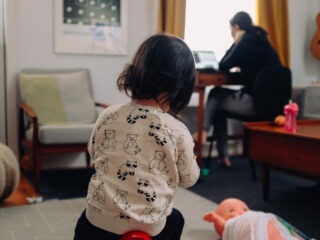Video production is a team sport: it requires a ton of planning before the shoot and then communication and collaboration on set to bring a story to life. Right now, the back lots of Hollywood and soundstages from Chicago to Toronto are as quiet as sports arenas and baseball stadiums. I have a buddy who works on movie sets, and everyone is trying to figure out how to get back to work. Options that have been floated include condensing film shoots to just a few weeks and quarantining the full cast and crew for the duration. This time is forcing all of us to rethink our traditional approaches.
Safety guidelines such as physical distancing create obstacles for the traditional video production. Still, companies need to get their messages out, and video remains a potent storytelling medium. Our video production leads—Mike, Laura, Alia, and me—put our heads together on how to confront this challenge and maintain quality. While a return to normalcy could be months or years away, the following options offer ways to keep the video train rolling.
Creative storytelling
Any scenes that require careful choreography of multiple actors won’t be possible for the foreseeable future. This footage is important not just to show interaction, engagement, and collaboration but also to illustrate scale and impact. So the ways we bring concepts or stories to life onscreen will have to change as well. Approaches include shoots with a smaller number of players and thoughtful setups that put people in the same room but deemphasize the distance. In addition, certain stories could end up being a mix of live video production, animation, and stock footage. These challenges can actually spur creativity, allowing stories to be told in different ways—sometimes with a more personal or human perspective.
“This type of filmmaking requires and inspires empathy,” Alia remarks. “What message are people seeking right now, and how will they receive it? Consider this short film Spike Lee released on Instagram in early May. All of the footage was shot around New York and the narrative of what’s happening in the city unfolds through the imagery. It feels very dire until the last few scenes, which convey a sense of optimism and resolve. When we don’t have all the usual tools at our disposal, it’s time to get a little gritty—and the outcome can pack an emotional punch that truly reflects this time in our shared history.”
Options to safeguard participants
Video production always involves making trade-offs on cost, coverage, and quality. The current environment calls for a smaller crew, and that can mean adopting a different mindset for the required roles. For instance, a production consisting of three people—cameraman with a minimal lighting package, audio technician, and production assistant—can work quickly and safely to capture the needed footage. And with careful planning and strategic compromises, the crew can ensure they always remain at a safe distance. To avoid air travel and the associated risk, we can draw on our national network to find the best crew in every major urban center. Another option is to shoot in a secure location and send a live feed to client sites. According to Laura, “If clients can’t be on-site for shoots or don’t want to travel, we can get a live feed to them somehow so they can participate in the shoot remotely.”
Remote directing
To further limit the size of the production and keep everyone safe, the director can engage with the crew and actors remotely. This is far from ideal, not least because remote directing creates a barrier for communication. In addition, sometimes you just don’t know how a scene will work until you see it play out in front of the camera. But providing the director with a live feed of the shoot and then allowing them to interact with the crew and actors via video chats can ensure they still have the flexibility to shape a scene.
This approach makes the selection of the crew, especially the cameraman, even more crucial. That person will act as the on-site quarterback. Remote direction also requires more up-front planning to ensure everything goes smoothly. “In one sense, filmmaking is all about problem solving,” says Mike. “Once you truly know your limitations, you can free yourself up to tackle any problem.”
Zoom videos as source material
When the pandemic hit, news programs, panel-based shows, and late-night talk shows quickly adapted to remote guests dialing in on Skype, Zoom, or other platforms. You may be completely over commercials that use this footage to tell a variation of the same story. But with the right preparation (basic lighting, microphones), people can take part in long-distance sit-down discussions that can be edited into a tight, crisp video. Laura notes, “I am currently working on a project that is using Zoom footage, and there are several ways to capture recordings as HD footage. Having a professional team working with you can assure quality will be as good as possible.” Regardless of the quality, remember that in any successful video, the narrative and execution are what will distinguish it from the competition.
***
The basics of safety—face masks, physical distancing—are well understood. As the months pass, we’ll learn more about how to manage the risk from the virus. We’ll continue to track new developments and adjust our approach to video production accordingly.




Leave a Reply
You must be logged in to post a comment.